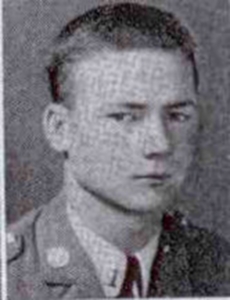Scroll of Honor – Stephen Randolph Hilton
Attack on Pagan
Written by: Kelly Durham
In 1937, the Imperial Japanese Navy established a garrison at the recently constructed airfield on Pagan Island, one of the  volcanic islands in the Marianas chain. The island was part of a League of Nations mandate granted to Japan after its participation in the Great War as a member of the victorious Allied powers. That same year, Louis Gray Clark of Walhalla enrolled in Clemson College.
volcanic islands in the Marianas chain. The island was part of a League of Nations mandate granted to Japan after its participation in the Great War as a member of the victorious Allied powers. That same year, Louis Gray Clark of Walhalla enrolled in Clemson College.
Louis Clark was a textile engineering major and was assigned to Company A, First Battalion, 2nd Regiment of the cadet brigade. Clark left campus after his freshman year.
When World War II broke out, Clark volunteered for the Army Air Force. He was selected for flight instruction and then funneled into fighter pilot training. After earning his second lieutenant’s commission and his pilot’s wings, Clark was assigned to the 73rd Fighter Squadron of the 318th Fighter Group.
The 73rd had been mostly wiped out during Japan’s December 7, 1941 attacks on Hawaii. It was reconstituted in May 1942 and deployed to Midway Island after the Battle of Midway. At the beginning of 1943, the squadron returned to Hawaii as part of the territory’s air defense force.
Newly equipped with P-47D Thunderbolt fighters, the squadron deployed to Saipan in the Northern Mariana Islands. It worked closely with Marine ground forces pioneering techniques in close air support of infantry. The squadron was the first to use napalm. On Saipan, the squadron achieved the rare distinction as one of the few Army Air Force units to be attacked directly by enemy ground forces in June 1944. After sustaining modest casualties, the pilots and ground crew took a crash course in infantry tactics.
 On August 22, 1944, Second Lieutenant Clark was ordered on a mission to attack the Japanese airfield on Pagan Island, some two hundred miles north of Saipan. He was slotted to fly as wingman to First Lieutenant Earl Harbour. The flight departed Saipan’s East Field and flew north. At about 1030 hours, Harbour completed a strafing pass from east-to-west over the Pagan airfield. When he looked back to check on his wingman, he saw Clark’s P-47 go into the water. Harbour saw Clark, under a parachute, drop into the sea only a quarter of a mile from the west-southwest shore of the island. Harbour orbited his wingman’s position and observed Clark floating in the water with his life vest inflated. Shortly thereafter, Harbour lost sight of Clark. Additional P-47s joined the search, as did a Navy PBM rescue plane. The search continued into the afternoon, but was called off at nightfall. Because the search planes were fired upon by Pagan’s Japanese defenders, Harbour speculated that Clark had either been captured by the Japanese or killed in the water by enemy fire. Clark was never recovered.
On August 22, 1944, Second Lieutenant Clark was ordered on a mission to attack the Japanese airfield on Pagan Island, some two hundred miles north of Saipan. He was slotted to fly as wingman to First Lieutenant Earl Harbour. The flight departed Saipan’s East Field and flew north. At about 1030 hours, Harbour completed a strafing pass from east-to-west over the Pagan airfield. When he looked back to check on his wingman, he saw Clark’s P-47 go into the water. Harbour saw Clark, under a parachute, drop into the sea only a quarter of a mile from the west-southwest shore of the island. Harbour orbited his wingman’s position and observed Clark floating in the water with his life vest inflated. Shortly thereafter, Harbour lost sight of Clark. Additional P-47s joined the search, as did a Navy PBM rescue plane. The search continued into the afternoon, but was called off at nightfall. Because the search planes were fired upon by Pagan’s Japanese defenders, Harbour speculated that Clark had either been captured by the Japanese or killed in the water by enemy fire. Clark was never recovered.
Second Lieutenant Louis Gray Clark was survived by his mother. He is memorialized at the Honolulu Memorial and at Silverbrook Cemetery in Anderson.
For more information about Louis Gray Clark see:
https://soh.alumni.clemson.edu/scroll/louis-gray-clark/
